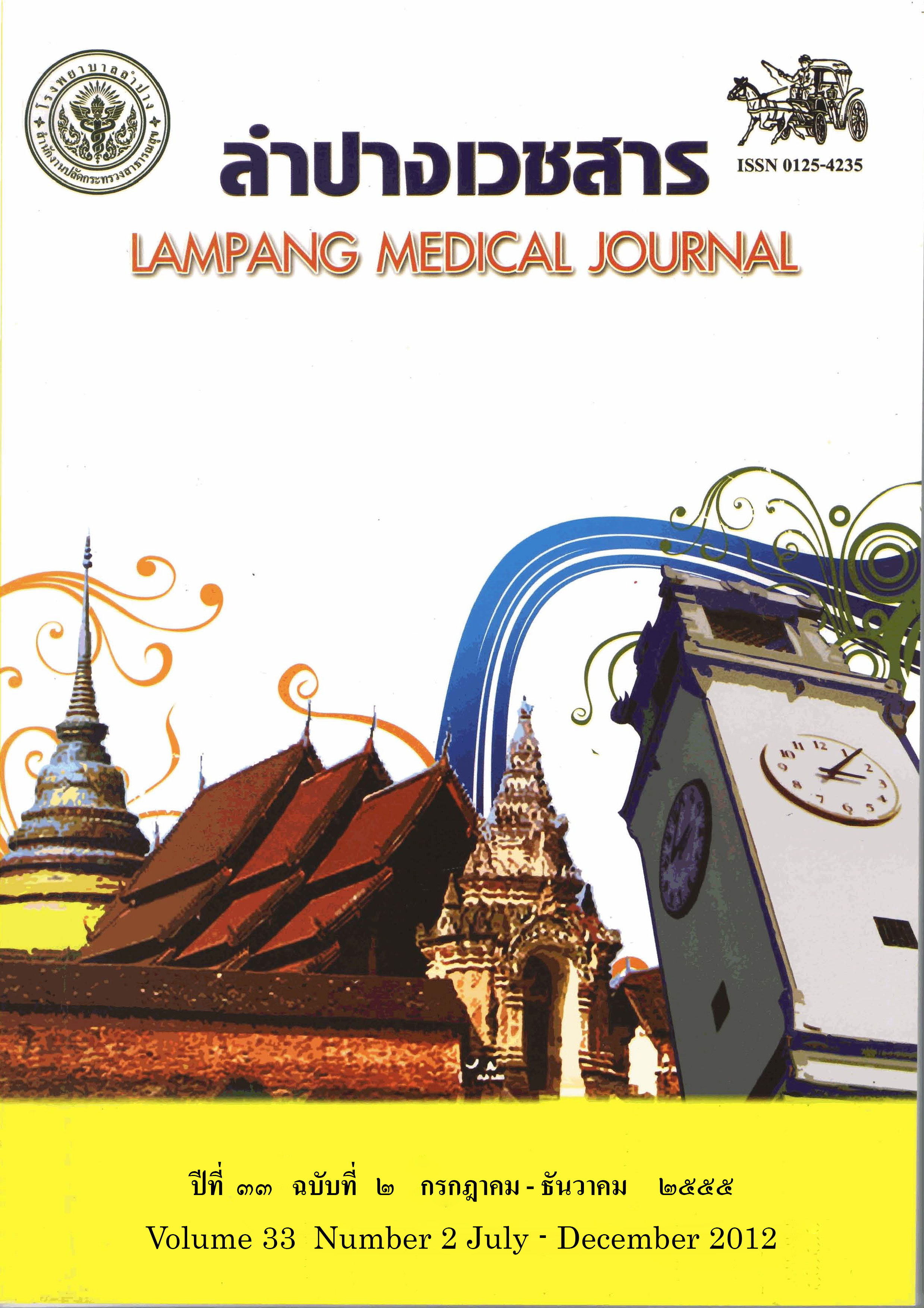การประยุกต์ใช้แนวคิดแบบลีนในการดูแลผู้ป่วย โรคหลอดเลือดสมองตีบหรืออุดตันระยะเฉียบพลัน จังหวัดลำปาง
Main Article Content
บทคัดย่อ
ภูมิหลัง: โรคหลอดเลือดสมองตีบหรืออุดตันระยะเฉียบพลันที่มีอาการน้อยกว่า 4.5 ชั่วโมง มาตรฐานการรักษาในปัจจุบันคือ การให้ยาละลายลิ่มเลือดภายใน 60 นาทีนับตั้งแต่ผู้ป่วยมาถึงห้องฉุกเฉิน รพ.ลำปางได้พัฒนาระบบช่องทางด่วนพิเศษโดยนำแนวคิดแบบลีน (Lean/Toyota production system principles) มาประยุกต์และเริ่มใช้ตั้งแต่เดือนกรกฎาคม พ.ศ. 2553
วัตถุประสงค์: เพื่อเปรียบเทียบตัวชี้วัด ผลการรักษา ภาวะแทรกซ้อน ก่อนและหลังการพัฒนาช่องทางด่วนพิเศษสำหรับโรคหลอดเลือดสมองตีบหรืออุดตันระยะเฉียบพลัน
วัสดุและวิธีการ: เป็นการศึกษาแบบ observational study ชนิด interrupted time ในผู้ป่วยโรคหลอดเลือดสมองตีบหรืออุดตันระยะเฉียบพลัน 62 รายที่ได้รับยา alteplase ที่ห้องฉุกเฉิน รพ.ลำปางตั้งแต่เดือนมิถุนายน พ.ศ. 2551 ถึงกุมภาพันธ์ พ.ศ. 2554 โดยแบ่งเป็น 2 กลุ่มคือ กลุ่มก่อน (pre-Lean) และหลังประยุกต์การใช้แนวคิดแบบลีน (post-Lean) จำนวน 28 และ 34 ราย ตามลำดับ บันทึกเวลาในแต่ละขั้นตอนการรักษา ภาวะแทรกซ้อน ผลลัพธ์การรักษาและอัตราตาย คำนวณร้อยละของผู้ป่วยที่ได้รับยาทันเวลาภายใน 60 นาทีและประสิทธิภาพของระบบ เปรียบเทียบระหว่างกลุ่มโดยใช้สถิติ Fisher’s exact probability และ t-test
ผลการศึกษา: ผู้ป่วยอายุเฉลี่ย 63.6 ± 12.7 ปี (พิสัย 38-91 ปี) ร้อยละ 51.6 เป็นเพศหญิง กลุ่ม post-Lean มีค่า door-to-needle time เร็วขึ้น (53.0 ± 20.5 นาที vs 75.0 ± 22.4 นาที, p<0.001) และตัวชี้วัดประสิทธิภาพของระบบเพิ่มขึ้นอย่างมีนัยสำคัญ (ร้อยละ 24.7 ± 2.3 vs 18.0 ± 1.8, p<0.001) ผู้ป่วยได้รับยาละลายลิ่มเลือดทันเวลาภายใน 60 นาทีเพิ่มขึ้นจากร้อยละ 32.1 เป็นร้อยละ 88.2 (p<0.001) พบภาวะแทรกซ้อนจากการมีเลือดออกในสมองน้อยกว่า (ร้อยละ 5.9 vs 7.1, p=1.000) อัตราการตายที่ 3 เดือนลดลง (ร้อยละ 8.8 vs 10.7, p=1.000) และมีผู้ป่วยที่อาการดีขึ้นเป็นที่น่าพอใจภายใน 3 เดือนหลังการรักษาสูงกว่ากลุ่ม pre-Lean (ร้อยละ 44.1 vs 21.4, p=0.105)
สรุป : การนำแนวคิดแบบลีนมาประยุกต์ใช้กับระบบช่องทางด่วนพิเศษ ในการดูแลผู้ป่วยโรคหลอดเลือดสมองตีบหรืออุดตันระยะเฉียบพลัน ช่วยลดระยะเวลาในแต่ละขั้นตอนการรักษา ทำให้ผู้ป่วยได้รับยาละลายลิ่มเลือดทันเวลามากขึ้นอย่างมีนัยสำคัญ ช่วยลดภาวะแทรกซ้อนและอัตราตายได้เล็กน้อยแต่ไม่มีนัยสำคัญทางสถิติ
Article Details

This work is licensed under a Creative Commons Attribution-NonCommercial-NoDerivatives 4.0 International License.
บทความที่ส่งมาลงพิมพ์ต้องไม่เคยพิมพ์หรือกำลังได้รับการพิจารณาตีพิมพ์ในวารสารอื่น เนื้อหาในบทความต้องเป็นผลงานของผู้นิพนธ์เอง ไม่ได้ลอกเลียนหรือตัดทอนจากบทความอื่น โดยไม่ได้รับอนุญาตหรือไม่ได้อ้างอิงอย่างเหมาะสม การแก้ไขหรือให้ข้อมูลเพิ่มเติมแก่กองบรรณาธิการ จะต้องเสร็จสิ้นเป็นที่เรียบร้อยก่อนจะได้รับพิจารณาตีพิมพ์ และบทความที่ตีพิมพ์แล้วเป็นสมบัติ ของลำปางเวชสาร
References
The National Institute of Neurological Disorders and Stroke rt-PA Stroke Study Group. Tissue plasminogen activator for acute ischemic stroke. N Engl J Med 1995;333(24):1581-7.
Hacke W, Kaste M, Bluhmki E, Brozman M, Dávalos A, Guidetti D, et al. Thrombolysis with alteplase 3 to 4.5 hours after acute ischemic stroke. N Engl J Med 2008;359(13):1317-29.
Jauch EC, Cucchiara B, Adeoye O, Meurer W, Brice J, Chan YY, et al. Part 11: adult stroke: 2010 American Heart Association guidelines for cardiopulmonary resuscitation and emergency cardiovascular care. Circulation 2010;122 Suppl 3:S818-28.
Suwanwela NC, Phanthumchinda K, Likitjaroen Y. Thrombolytic therapy in acute ischemic stroke in Asia: The first prospective evaluation. Clin Neurol Neurosurg 2006;108(6):549-52.
Graban M. Lean hospitals: improving quality, patient safety, and employee engagement. 2nd ed. Boca Raton: Taylor & Francis;2011. p.17-29.
Ng D, Vail G, Thomas S, Schmidt N. Applying the Lean principles of the Toyota Production System to reduce wait times in the emergency department. Can J Emerg Med 2010;12(1):50-7.
Melanson SE, Goonan EM, Lobo MM, Baum JM, Paredes JD, Santos KS, et al. Applying Lean/Toyota production system principles to improve phlebotomy patient satisfaction and workflow. Am J Clin Pathol 2009;132(6):914-9.
Rutledge J, Xu M, Simpson J. Application of the Toyota Production System improves core laboratory operations. Am J Clin Pathol 2010;133(1):24-31.
Goldstein LB, Samsa GP. Reliability of the National Institutes of Health Stroke Scale. Extension to non-neurologists in the context of a clinical trial. Stroke 1997;28(2):307-10.
Sulter G, Steen C, De Keyser J. Use of the Barthel index and modified Rankin scale in acute stroke trials. Stroke 1999;30(8):1538-41.
Yamaguchi T, Mori E, Minematsu K, Nakagawara J, Hashi K, Saito I, et al. Alteplase at 0.6 mg/kg for acute ischemic stroke within 3 hours of onset. Stroke 2006;37(7):1810-5.
Nakagawara J, Minematsu K, Okada Y, Tanahashi N, Nagahiro S, Mori E, et al. Thrombolysis with 0.6 mg/kg intravenous alteplase for acute ischemic stroke in routine clinical practice. Stroke 2010;41(9):1984-9.
Toyoda K, Koga M, Naganuma M, Shiokawa Y, Nakagawara J, Furui E, et al. Routine use of intravenous low-dose recombinant tissue plasminogen activator in Japanese patients. Stroke 2009;40(11):3591-5.
Dharmasaroja PA, Dharmasaroja P, Muengtaweepongsa S. Outcomes of Thai patients with
acute ischemic stroke after intravenous thrombolysis. J Neurol Sci 2011;300:74-7.
Ueshima S, Matsuo O. The differences in thrombolytic effects of administrated recombinant t-PA between Japanese and Caucasians. Thromb Haemost 2002;87(3):544-6.
Wahlgren N, Ahmed N, Dávalos A, Ford GA, Grond M, Hacke W, et al. Thrombolysis with alteplase for acute ischaemic stroke in the safe implementation of thrombolysis in strokemonitoring study (SITS-MOST): an observational study. Lancet 2007;369(9558):275-82.
Hacke W, Kaste M, Fieschi C, von Kummer R, Dávalos A, Meier D, et al. Randomised double-blind placebo-controlled trial of thrombolytic therapy with intravenous alteplase in acute ischaemic stroke (ECASS II). Lancet 1998;352(9136):1245-51.

